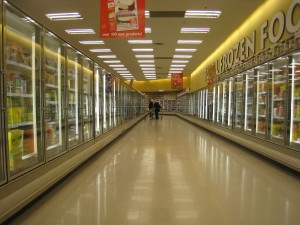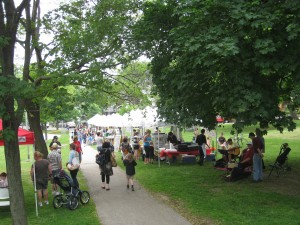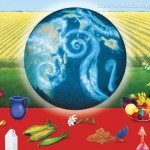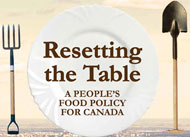Author Archive
Can’t afford to go to Europe this summer? Not to worry, Canada is bringing Europe here.
Canada and the European Union have reached an agreement on an equivalency in organic products. The agreement comes after almost four years of negotiations involving a long review of each other’s rules for organic food production and control systems.
The idea is to increase trade on both sides of the pond, no to mention boost Canada’s organic sector.
Suppliers can now import and export certified organic products between Canada and the EU without the need for additional certification. This means new markets for organic farmers and much less paperwork.
This is a good thing, right? More organics means more land is being used to produce food in a responsible and sustainable way. So yes, this is good. But I submit that local organic is still the way to go when possible.
Our Canadian market is already inundated with US-based organic products that often mirror mainstream food’s infrastructure in its packaging and transportation practices. Even non-organic local food, when in season, with its absent or minimal packaging and small carbon footprint, makes a better argument for sustainability.
So yes, buy EU organic. Let’s have a healthy, competitive organic market. But don’t neglect your local market — because if you want tasty, healthy food, fresh is still best.
I am tired of people complaining about the cost of food. I know, I sound like a terrible human being. Yes, prices are going up, and of course food has to be affordable. But we are pretty spoiled here in North America compared to the rest of the world when it comes to many things, and the price of food is no exception.
Take a minute to consider how much (or little) of our income that we actually spend on food compared to other nations:
• USA 9.6%
• UK 11%
• Japan 17%
• South Africa 27%
• India 53%
If you’re in North America, you’re spending less than 10% of your income on food. This figure used to be much higher. But believe it or not, it has been steadily decreasing over the past 90 years.
And now, after all this time, the landscape is changing.
The UN Food and Agriculture Organization (FAO), led by newly appointed Jose Graziano da Silva, says the increase is due to bad weather (droughts and floods in food producing areas), high demand, and a switch to higher protein diets. There was much talk about food shortages in 2009, and in February 2011, the FAO Food Price Index reached an all time high — this is a measure of the monthly change in international food commodity prices.
Mr. Graziona says prices are going to stay high — and volatile. And volatily, he says, is worse than high prices, because farmers are hesitant to invest in agriculture for fear of not making their return. Graziano partly blames this volatility on the “financialization” of key commodities by financial markets, i.e. speculation.
The price of food in Canada is rising, but we will not likely feel it until the end of the year, when according to the Globe & Mail — the rising cost of wheat, soy, corn, sugar and vegetable oil will have trickled down and be reflected in supermarket prices.
The UN points the finger for all this at the rising cost of crude oil. While it’s true the cost of wheat has doubled, the cost of wheat makes up only 15 cents of the price of a loaf of bread. The rest comes from processing, packaging, overhead and transportation.
Rising fuel prices are much more of a factor. 1L gasoline is up by 20% from last year, and the price of diesel, used by most transport trucks, is up 30% from last year. This will have a major trickle down effect on… well, everything.
So what can you do to minimize the strain? There are different ideas out there floating around. Start growing your own food during the warmer months to reduce food bills. Buy as local as you can to minimize the distance the food must travel. Buy food that has as little processing and refining as possible — to avoid the costs that each of these stages adds on.
One piece of advice was deceptively simple and made me laugh:
Use all the plant. Save the bones for soup. Freeze and can and jam and pickle the food you do have to stretch it as far as it will go — because the current lifestyle to which we have become accustomed may well be changing.
Get the real deal with certified local farmers’ markets.
Have you been to a MyMarket? After being told by those who know I that I had to check out a MyMarket, I took advantage of some free time today and cycled over to East Lynn Park’s Thursday afternoon market — a small but growing neighbourhood farmers’ market just a stone’s throw from Woodbine and the Danforth.
Like the other MyMarkets around Toronto, East Lynn is certified MyPick™, which means the farms have been verified as authentically local, and the items the farmer is selling truly come from his or her farm. I.E. you are buying direct. No middleman. No food depot. No farmy re-packaging of someone else’s produce. It’s what a farmers’ market should be.
Diana Gonzalez, Toronto District Supervisor for MyMarket, explained to me that MyMarket inspectors go so far as to check the farmers’ seed invoices, as well as crops in the ground or livestock being raised, to ensure everything is on the up and up. And on every market day, market managers check that the items each farmer is selling match up with activities back at the farm.
All very impressive, right? That’s a lot of legwork and effort and time to make sure that the dollars you devote to supporting local food truly support local food.
It’s great. It’s crazy. It’s wonderful. I’m dizzy. So why aren’t we all shopping there?
Chatting with some of the farmers, I learned that shopper turn out can sometimes be quite poor – something they couldn’t understand because of “all houses all around us!” East Lynn is a relatively new market. If the neighbourhood wants to have continued access to fresh strawberries, sweet peas, wildflower honey, maple syrup and lamb chops, not to mention all the other baked treats I saw, it’s time to step up and show your support!
If we don’t support the local markets, our local farmers won’t bother coming in to see us, and we’ll be forced to shop for depot food at the supermarket.
C’mon out folks. It was a late spring, but it’s all coming up roses now!
In a follow-up article, the Toronto Star reports that the food service company that once fed 75 day-care and Montessori schools supposed organic, kosher and halal meals has shut its doors.
It’s all very mysterious.
Whole Green Kids somehow managed to pull a fast one on schools and parents of children with allergies, and who follow faith-based food preparation traditions.
The provider of so-called ‘premium’ meals has apparently been moving shop over the past few months to avoid paying kitchen rent. Meanwhile the owner, Susan Blouin, lives in a $2 million home and drives a Porsche. Really? I mean really??
It’s actually all very disturbing.
I have a lot of faith in the good food movement. I pay extra for organic. I eat local. I push the ideal and do my best to convert friends. I also occasionally work in catering, and have great respect for reputable companies like Sublime Catering and Real Food for Real Kids.
And I think there is great potential for more good food to be available in our everyday, non-elite lives – because the general population is becoming more food-literate, consumers more savvy, and deadly e-coli outbreaks remind us we have to be vigilant about the quality of our food.
But this company is casting a dark cloud on my parade. And it pisses me off.
If you’re concerned about the quality of food being provided to your children, I encourage you to check out the claims made by the food service or catering company you use. Don’t assume they’re pulling a fast on you; as I see it, Whole Green Kids is the exception, not the rule. But you have every right to feel comfortable about the food someone else is selling you.
Last night, a friend sent me a Toronto Star article about the downward spiral of Whole Green Kids, an Ontario catering company that specializes in preparing organic, kosher and halal meals for children.
If the allegations are true, and this company has been passing off discount supermarket fare as homemade, wholesome and prepared according to religious traditions, it is a sad day for catering companies.
All the more reason to value the good ones that are out there!
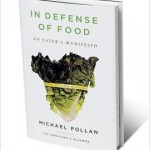
In Defense of Food – An Eater’s Manifesto
By Michael Pollan
It’s hard to know where to start with this book review. Pollan touches on so much; the term “manifesto” in the title is no understatement. And yet throughout the twists and turns that explore our perceptions of and our relation to food, Pollan always remains squarely focused on his one, simple, yet surprisingly challenging credo:
Eat food. Not too much. Mostly plants.
Pollan begins with the demise of Mom as controller, boss and decision-maker over the evening meal. When we as a society replaced Mom’s authority over our food choices with advice from scientists and food marketers, we all began to suffer. After all, who really had our best interest at heart?
For decades now, big agriculture has focused on growing produce with synthetic chemicals and raising livestock on pharmaceuticals. The goal is return, quantity and profit. The side effect of this is that our food has been transformed from something we could identify (…grape, …cow) and eat without worry, to the confusingly refined, enriched and modified cacophony of chemicals that we call food today.
To help us understand these food-like substances, we have turned to the professionals for guidance—government food guides, dieticians, nutritionists, trainers and celebrities (who learned from nutritionists and trainers). And so we learned about nutrients and micronutrients, and now we worry over vitamin D, anti-oxidants and essential fatty acids.
Pollan uses the term nutritionism to describe this focus on nutrients and our tendency to break our food down into its parts. He asks his readers to return to seeing food as something that is whole in itself, not a series of parts. Eat an apple not because it contains vitamin C and a nice mix of soluble and insoluble fibre, but because apples are good for you and we know this from millennia of eating them.
With food science in its infancy, Pollan suggest we revert our trust to our traditional food knowledge. The eating habits of our grandparents and ancestors allowed them to survive because the methods were tried and true. The diversity of traditional diets (Greek, French, Japanese, Indian, Mexican, whatever) is proof it’s possible to nourish ourselves from a huge range of different foods—as long as they are food.
In the west, our current dietary focus on processed corn, wheat and soy is a direct result of what’s easy and fast to grow, ship and store. The apparent focus of our agricultural system on quantity over quality, and the goal to produce as many calories per acre as possible, regardless of nutritional value, is leading us down the garden path and straight into the arms of our Western diseases: obesity, diabetes, hypertension, and heart disease.
Instead of chasing elusive super foods to cure our ills, Pollan asks us to re-visit our perception of one of the most basic necessities of life. Is more necessarily better? Are new scientific discoveries more reliable than traditional knowledge? Who really should be deciding what goes into your stomach?
This is, needless to say, a must read.
I’m beginning to realize there is food all around us.
Wild carrots. Wild leeks. Dandelions (of course). Bergamot. Cattails. Wild strawberries. Ostrich fiddle heads. The list goes on.
I had the pleasure of taking a wild edibles* class at Humber College last weekend. It doesn’t get more local than this – just walking around a field or wood, seeing what you find growing there naturally and eating it.
Of course, exactly what we consumed was closely guided by Dave Arama of WSC Survival School, who teaches the class.
The surprising thing was how delicious some of these foraged foods were! I am not kidding. The young needles of the tamarack tree, eaten as a type of candy by native peoples, had me leaving the group and going back for seconds. As for the leaves of the dogtooth violet, I was going for thirds and fourths.
One of my favourite trees, the staghorn sumac, has edible berries that you can eat (similar to a pomegranate, but fuzzy) or make into a type of lemonade (sumac-ade, I suppose).
It was an eye-opener. The tricky part is knowing how to distinguish between your tasty edibles and the poisonous look alikes. For that you either need to commit to the learnin’ or have an expert with you at your side.
Thanks David! It was fun. I’m looking at my surroundings a little differently now and looking forward to the next course on June 4!
*Course title: Edible Plants, An Introduction
A film by Deborah Koons Garcia, 2004 (Lily Films)
5 years old but still relevant.
I just saw The Future of Food (2004), a documentary film by Deborah Koons Garcia. This is a noteworthy film from the early days of GMO awareness in the United States. It explores the quiet introduction of GM (genetically modified) foods into our food system. Focusing on the story of BT corn, canola and soy, this interesting little film explores on the plight of the small family farmer vs the likes of Monsanto Inc. We meet Percy Schmeiser, of Saskatchewan, and Rodney Nelson, of North Dakota, two farmers who had the audacity of having Monsanto patented GM seeds blow onto their fields. Their stories are shocking and reveal the pervasiveness of Monsanto’s tentacled reach into the FDA, government policy and legal system.
If you haven’t seen it, definitely worth a watch
It’s spring, right? And you want to know what’s in season in Ontario now.
Veggies:
Beets, cabbage, carrots, greenhouse cucumbers, greenhouse lettuce, mushrooms, onions, parsnips*, greenhouse peppers, rutabaga, sprouts, sweet potatoes and greenhouse tomatoes.
Fruits:
Apples and rhubarb.
According to Foodland Ontario, the above foods are “scheduled” for April. But with the slow spring we have this year, it might be better to expect them to arrive closer to May. All the same, it’s almost May so keep an eye out!
*Not a parsnip fan? Try this recipe given to me by my old CSA, La ferme de Bullion, in Québec. It’s surprising how eating a good-for-you, local food prepared in a new way can make you feel like a super star.
Parsnip Pancakes
4 cups parsnip peeled and cubed
2 eggs slightly beaten
1 onion finely chopped
1 tsp salt
1 tsp oil
1/2 cup finely chopped walnuts
1 tsp dried tarragon
2 cups breadcrumbs
Steam parsnips until tender (10-15 mins). Sauté onion in oil, add tarragon.
Mash parsnips; add onion, egg, salt and nuts and mix well. Form into 12 patties.
Coat with breadcrumbs. Bake at 350F for 20 minutes.
Mmm mm.
(Ontario garlic might make a good addition too.)
Canada now has a citizen-driven food policy.
The People’s Food Policy (PFP) was unveiled this past week as a plan that addresses some of this country’s most confounding food-related inconsistencies, including why close to 2.5 million Canadians don’t have enough to eat, while one in four of us is considered obese.*
What is new here is that the PFP looks at our food system and recognizes its inter-connectedness with issues of health, hunger, climate and agriculture. Food and agri are often associated, but to include health, hunger and climate in the picture is nothing short of revolutionary for this country.
I guess that’s what happens when regular citizens get involved. The PFP consulted regular Canadians, farmers, fishers and organizations that deal with food security.
What did the inquiry find? Basically that our food system is failing us, and the status quo is not an option, says Amanda Sheedy, PFP coordinator.
Key PFP recommendations:
- Localizing the system so that food is eaten as close as possible to where it is produced.
- Supporting food providers in a widespread shift to ecological production, including programs to support new farmers getting on the land.
- Enacting federal poverty elimination and prevention programs to ensure Canadians can better afford healthy food.
- Creating a nationally-funded children and food strategy.
- Ensuring that the public, is actively involved in decisions that affect the food system.
Here, here!
The new People’s Food Policy site just launched, so take a minute to sign their pledge for a healthy, fair and ecological food system.
*<rant>
Of course, this might be due the plethora of inexpensive, nutrient-poor, food-like products that pass for food on supermarket shelves that fill us up but leave us malnourished.
</rant>

